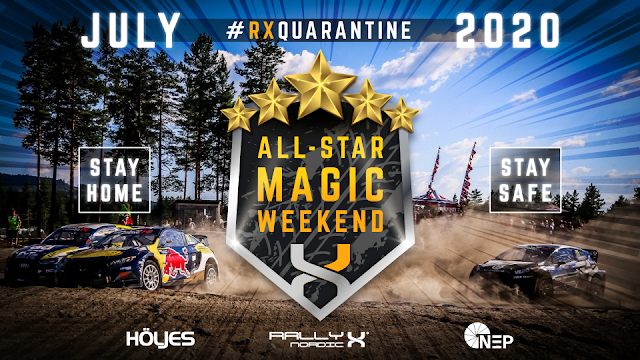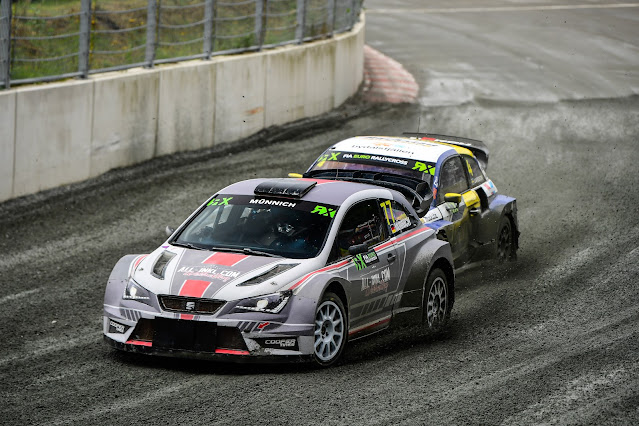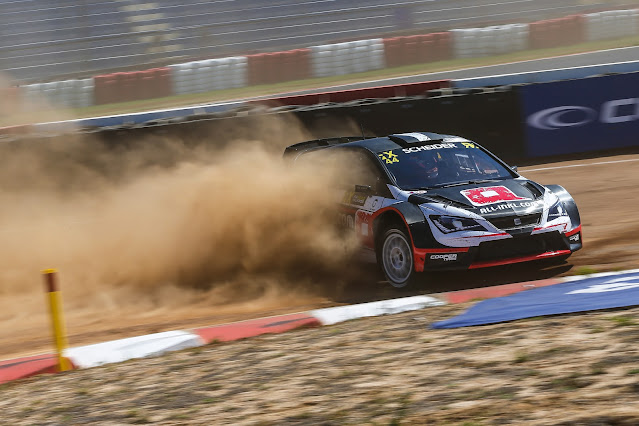 |
David Mansfield reviewing data/video with Guerlain Chicherit and Liam Doran.
PHOTO CREDIT: GC Kompetition. |
Up top! Right there! Clear high! Two behind! These are terms that you’ve mostly like heard while watching IndyCar or NASCAR. The FIA World Rallycross Championship is no different, as the world’s best drivers battle on track for the best result possible, these drivers also have their own set of eyes perched high in a spotters tower with one aim to assist their driver to maximize their performance on track.
The main role of a spotter is to keep their driver-focused and informed of what is ahead of them as well as providing real-time information about the cars in the immediate vicinity, and in the case of rallycross they also assist with joker lap strategies as well.
In the FIA World Rallycross Championship, there is a special tower for spotters where they are able to look over the circuit (higher vantage point) and have live video and timing screens at hand to give their driver(s) all the information they require to assist their driver, and when to potentially take the Joker lap.
In order to learn a bit more about spotters or spotting in World RX, we speak to none other than David Mansfield from GC Kompetition (GCK) about his road to RX, the role within the sport and more.
Some of you might not know David Mansfield, so let’s get to know a bit more about him and where it all began for him in Rallycross.
“I got started with rallycross at a national level in 2008 when I was working alongside Liam Doran at Lydden [Hill] preparing the circuit to bid for the European Rallycross championship back to the UK for the first time in 20+ years,” he said.
“Once we secured the European championship and the circuit was up and running I went on the road to help Liam and his team across all the championship events taking on a performance role that eventually lead to becoming a spotter when they were introduced way back in 2012 ish…”
Having been involved in World RX for a few years now, and to properly understand the role of a Spotter in the short, sharp, action-packed championship, we asked David about his role within the sport.
 |
Anton Marklund and Guillaume de Ridder on the joker lap in Cape Town.
PHOTO CREDIT: Junaid Samodien
|
“The role has developed over the years from just “saying what you see” and keeping the driver safe and aware of what they can’t see from inside the car... to nowadays taking the race results into your hands by running strategy in real-time, especially since the joker lap has become a huge part of every race,” he explains.
“There are some interesting calls from spotters and I’m one of the first to play armchair quarterback and shout or laugh at the screen when you see some of the decisions being made. But it’s certainly difficult to understand everything from the outside watching in, especially as there’s so much data in the spotters tower that you have to process within a short period of time to try and get the best result every lap for your driver and team.”
“So understanding the thought process and what some of the spotters are planning is a tall order. Especially when you take into account that teams have a set plan with a few different scenarios or strategy plays they can make before the start of each race. Usually, that plan goes up in smoke once the light goes green and the cars are at the first corner, and this is where the experience comes in."
Mansfield explains that running reactive race strategies helps but if you don’t achieve the desired result, you as a spotter/strategies should prepare to have a helmet or boot thrown at you.
“In all the teams I’ve worked for I’ve been allowed to run a reactive race strategy and that helps a ton but you have to be prepared to have a crash helmet or even race boots thrown at you if you make the wrong call and the driver isn’t happy with the race result so it’s a fine line between glory or maximum misery!”
While the role of spotting in NASCAR and IndyCar versus World Rallycross is not too different, the only real comparison is the length of the races. But, how does spotting in NASCAR and IndyCar differ to the role of spotting in Rallycross?
“I’ve only recently been aware of spotters in other forms of motorsports to be honest and I’m now friends with a few NASCAR spotters because of the work I do with the American rallycross events,” he said. “You definitely need more endurance to spot for NASCAR or Indy car as the races are longer so it’s not my thing but I assume it’s similar to the sport of fishing... pack some snacks, wack on the sun cream and chill for a few hours watching the world go by.”
Every job requires special training courses or University degrees etc. before you are allowed to apply or start working in the specified profession. Is there anything specific that someone would have to study or a special skills they are required to have to join Rallycross as a spotter?
“They say to master anything you need to practice for 10,000 hours. I kinda believe that especially with something like spotting because of all the possible scenarios,” Mansfield said. “I know I’m only approximately 5,000 hours into watching race re-runs and onboards from previous years but to fast track the skill I work with multiple teams and drivers in as many different championships as possible to stay sharp.”
As they say: ‘practice makes perfect’. So, does David Mansfield have any secrets when it comes to improving his skill as a spotter.
“There is one secret to get really good at spotting that I used when I first started. That’s to focus on whoever you think is the best spotter in each race and study their calls and try to figure out why they make these calls. It helped me a bunch in the beginning learning by watching Kenneth Hansen and his team in my first few years in European Rallycross and cross-referencing calls with the drivers to see their opinions of the strategy,” he said. “It would be like a boxer trying to impersonate Ali’s style and if they have the guts to get in ring that would give them a pretty big head start.”
Accuracy is key in motorsport. Without accuracy in engineering, mechanical, or even spotting a driver could lose valuable time or even positions in a race. How accurate do you actually need to be as a spotter? And, are you required to forecast incidents, time splits, etc.
“This depends on the spotters ability and the drivers capacity to take in information during the race. I’ve worked with 27 supercar drivers to this point and all of them are different so you have to adjust accordingly,” he said.
Drivers often have preferences with regard to the information they want the spotter to provide. Mansfield explains: “Someone like Andreas [Bakkerud] just needs the clear concise facts whereas Liam wants to know much more during the race so there is little left for him to think about what’s happening around him.”
“In some cases when I’ve seen it coming I’ll tell a driver they are about to be hit and give them a quick 321 countdown so they can adjust for the hit. Sometimes this pays off others I forget to press the button! Haha”
Whilst David leads the way for GC Kompetition in the spotters tower and studying telemetry. He admits that his main role within the team is to brew a mean cuppa tea. We can not verify this fact as we are yet to try his tea.
“Yes reviewing telemetry in between races using the vbox system and my main role is BREW CHIEF... I make a mean cuppa tea being English as you can imagine,” he said.
Reflecting on the past few years in World Rallycross, we asked David what has been his best highlight as a spotter. He immediately points out Andreas Bakkerud’s record-setting clean sweep in Norway 2016.
 |
David Mansfield with Guerlain Chicherit.
PHOTO CREDIT: GC Kompetition. |
“What springs to mind as a highlight would be Andreas’ perfect race weekend in Norway. I laterally said turn in twice and joker 6 times and Andreas won the event and scored a perfect 30 points for a clean sheet. It’s epic when you’re watching how a driver pulls off a great turn 1 move and ends up 1st, that’s when it gets interesting because it’s then on the spotter if they win the race or not,” he explained.
From time-to-time while watching NASCAR or IndyCar you’d hear this spotter calls, this is slightly different in World RX. Spotter calls aren’t broadcast, and in order to draw a picture of what a spotter would actually, tell their driver we asked him if he’d give us an example of what he’d tell his driver in a before, during, and after a race.
“Not a chance that the secret sauce and why I’ll be wearing a mask this season so nobody can read my lips…. Haha,” he jokingly says.
In 2020, GC Kompetition will have six drivers on the World Rallycross grid. Surely, Mansfield won’t be responsible for all the drivers.
“[I’m] responsible for making the tea and providing light-hearted moral boosting entertainment across all drivers but I guess I’ll just be working with one or two of the drivers if this season ever actually gets going.. as to who you will have to wait and see I guess,” he said.
A very special ‘Thank You’ to David Mansfield for taking some time out of his day to discuss the world of spotting with us. We’d also like to thank Nini Mikolajski (Roots) for arranging the interview.
Written By – Junaid Samodien
























